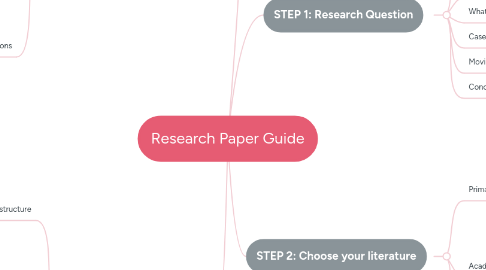
1. STEP 3: Structure of your paper
1.1. Essential components of a research paper
1.1.1. 1) You need an original title for your paper.
1.1.2. 2) Readers pick up important clues about the purpose and structure of the paper from the introduction.
1.1.3. 3) Present your thesis statement in the introduction.
1.1.4. 4) In the body of the paper, develop your argument, supporting it with evidence.
1.1.5. 5) The conclusion must focus on the following elements:
1.1.6. 6) Write an abstract and provide a list of key words.
1.1.7. 7) For a thesis, add an appendix and a glossary of terms, if needed.
1.1.8. 8) For a thesis, a detailed table of contents is required.
1.2. References and Citations
1.2.1. DO NOT PLAGIARIZE.
2. STEP 4: Writing, formatting, and presenting your paper
2.1. Formatting and structure
2.1.1. Word count for a thesis: 15000-20000 words.
2.1.2. Please remember to include page numbers.
2.2. Language
2.2.1. 1) Use advanced writing tools for grammar checking and spell checking.
2.2.2. 2) Always try to be as specific as possible.
2.2.3. 3) You avoid using words and phrases that fall into the following categories:
2.2.3.1. Jargon
2.2.3.2. Clichés
2.2.3.3. Everyday abbreviations
2.2.3.4. Slang
2.2.3.5. Gender-biased language
2.2.4. 4) Avoid using contractions
2.2.5. 5) Avoid extensive nominalization and passive voice.
2.2.6. 6) Avoid dramatic vocabulary:
3. STEP 1: Research Question
3.1. What is the topic that interests you the most?
3.2. What is the issue that you want to know more about within this topic?
3.3. What question do you want to ask?
3.4. Cases
3.4.1. A Case Study
3.4.1.1. A cross-case study
3.5. Moving from theory to argument
3.5.1. Theory
3.5.1.1. Hypothesis
3.5.1.1.1. Evidence
3.6. Conceptualization and Operationalization
4. STEP 2: Choose your literature
4.1. Primary vs. Secondary sources
4.1.1. Be careful with newspapers. Newspapers can be treated as both secondary and primary sources, depending on your research question.
4.2. Academic vs. Non-Academic sources
4.2.1. Professionals in a given field write academic sources.
4.2.2. Non-academic sources are written for the mass public. Their language is geared to any educated audience, but the language could also be informal, casual, and may contain slang.
